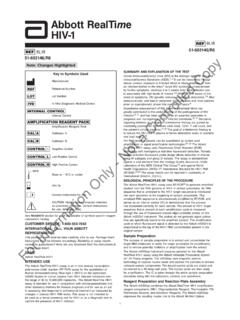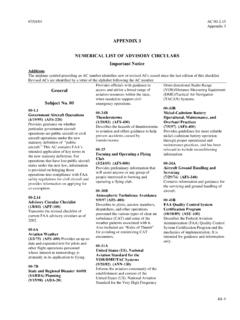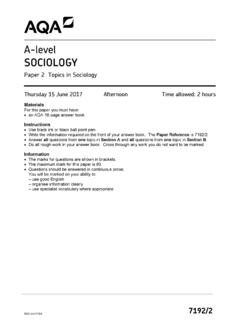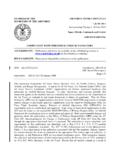Transcription of Vysis D7S486/CEP 7 FISH Probe Kit en - Abbott …
1 1en 04N78-02030-608510/R1 Key to Symbols UsedManufacturerReference NumberLot NumberIn Vitro Diagnostic Medical DeviceGlobal Trade Item NumberContains sufficient for <n> testsTemperature LimitCaution, consult accompanying documentsRefer to WARNINGS AND PRECAUTIONS sectionRefer to WARNINGS AND PRECAUTIONS sectionRefer to WARNINGS AND PRECAUTIONS sectionRefer to WARNINGS AND PRECAUTIONS sectionBiological RisksConsult instructions for useUse ByAuthorized Representative in the European CommunityCUSTOMER SERVICE: 1-800-553-7042 CUSTOMER SERVICE INTERNATIONAL: CALL YOUR Abbott REPRESENTATIVENAMEV ysis D7S486/CEP 7 FISH Probe KitINTENDED USEThe Vysis D7S486/CEP 7 FISH Probe Kit is a device intended for specimen characterization and detects the LSI D7S486 Probe target on chromosome 7q31 and the CEP 7 Probe target on chromosome in bone marrow and peripheral blood specimens from patients with acute myeloid leukemia or myelodysplastic syndrome.
2 The assay results are intended to be interpreted by a qualified pathologist or cytogeneticist. This device is not intended for high-risk uses such as selecting therapy, predicting therapeutic response or disease screening. The use of this device for diagnosis, prognosis, monitoring, or risk assessment has not been AND EXPLANATION OF THE TESTA typical FISH signal patterns or 1R1G and 1R2G are recurring abnormalities in several hematologic malignancies. Vance et al1 demonstrated the Vysis LSI D7S486 SpectrumOrange/CEP 7 SpectrumGreen Probes detected a 1R2G signal pattern of the locus specific identifier (LSI) D7S486 Probe target on chromosome 7q or 1R1G signal pattern on chromosome 7 (monosomy 7) in a series of bone marrow and blood specimens from untreated acute myeloid leukemia (AML) patients. In the study, 179 bone marrow specimens and 47 peripheral blood specimens were tested.
3 Among the 179 bone marrow specimens tested, 4 bone marrow specimens were atypical for the 1R2G FISH pattern associated with the LSI D7S486 Probe target on chromosome 7q with a range of 58 to 93% atypical nuclei. Among the 179 bone marrow specimens tested, 5 bone marrow specimens were atypical for the 1R1G FISH pattern with a range of 70 to 96% atypical nuclei. Among the 47 peripheral blood specimens tested, 1 peripheral blood specimen contained the 1R1G atypical FISH pattern in 11% of nuclei. An additional 3 peripheral blood specimens were atypical for the 1R2G FISH pattern with a range of 37 to 96% atypical nuclei. Cherry et al2 reported the Vysis LSI D7S486 SpectrumOrange/CEP 7 SpectrumGreen Probes detected 1R2G in 3 myelodysplastic syndrome (MDS) patients with a range of to 44% atypical bone marrow nuclei and also detected 1R1G in 2 patients with 23 and atypical nuclei.
4 Tefferi et al3 described 2 myelofibrosis with myeloid metaplasia (MMM) patients who had 9% and 16% bone marrow nuclei with 1R2G atypical signal patterns. A peripheral blood specimen from the MMM patient with 16% atypical bone marrow nuclei had 27% of nuclei with the 1R2G atypical signal pattern. The peripheral blood specimen from the patient with 9% 1R2G bone marrow was determined to be typical. However, the author stated that the percent of atypical nuclei may have been below detection limits in this peripheral blood Vysis D7S486/CEP 7 FISH Probe kit uses FISH DNA Probe technology to detect the Probe target for LSI D7S486 (7q31) on chromosome 7q and the Probe target for CEP 7 ( ) on chromosome PRINCIPLES OF THE PROCEDUREDNA Probe DescriptionVysis LSI D7S486 SpectrumOrange/ CEP 7 SpectrumGreen ProbesVysis LSI D7S486 SpectrumOrange/ CEP 7 SpectrumGreen Probes are a mixture of a SpectrumOrange D7S486 Probe (7q31) and a SpectrumGreen CEP 7 Probe ( ).
5 The SpectrumOrange-labeled LSI D7S486 Probe is approximately 308 Kb in length (chr7: 115983468-115675366; February 2009 Assembly UCSC Human Genome Browser).4 The SpectrumGreen-labeled CEP 7 Probe targets the D7Z1 alpha satellite sequence at the centromere of chromosome D7S486/CEP 7 FISH Probe KitVysis D7S486/CEP 7 FISH Probe Kit 04N78-02030-608510/R1 For Information Only - Not a Controlled Copy2 General Reagents DescriptionVysis LSI/WCP Hybridization BufferVysis LSI/WCP Hybridization Buffer consists of dextran sulfate, formamide, and standard sodium citrate (SSC), which is used to promote rapid specific II Counterstain DAPI II Counterstain consists of DAPI (4 ,6-diamidino-2 MEBKVIFKALIBm % I > !+ PMB@FCF@ CIRLOLMELOB >KA 1,4-phenylenediamine (an antifade compound used to reduce the tendency of the fluorophores to diminish in intensity) in a glycerol and phosphate buffered saline NP-40 is a non-ionic surfactant that is used in the aqueous post-hybridization wash SSC Salt20X SSC Salt is composed of sodium chloride and sodium citrate.)
6 It is used to make 20X SSC solution and subsequent dilutions for wash DescriptionFISH is a technique that allows visualization of specific nucleic acid sequences within a cellular preparation. Specifically, FISH involves precise annealing of a single-stranded, fluorophore-labeled DNA Probe to a complementary target sequence. Hybridization of the Probe with the cellular DNA site is visible by direct detection using fluorescence microscopy. Interpretation of FISH results should be made utilizing appropriate controls and analytical techniques as well as taking into consideration other clinical and diagnostic test marrow or peripheral blood cell specimens attached to microscope slides using standard cytogenetic procedures are used for this assay. The resulting specimen DNA is denatured to single-stranded form and subsequently allowed to hybridize with the probes of the Vysis D7S486/CEP 7 FISH Probe Kit.
7 Following hybridization, the unbound Probe is removed by a series of washes, and the nuclei are counterstained with DAPI II, a DNA-specific stain that fluoresces blue. Hybridization of the Vysis LSI D7S486 SpectrumOrange/CEP 7 SpectrumGreen Probes is viewed using a fluorescence microscope equipped with appropriate excitation and emission filters, allowing visualization of the orange and green fluorescent a cell with typical copy numbers of the Vysis LSI D7S486 SpectrumOrange/CEP 7 SpectrumGreen Probe targets, 2 orange (2R) signals (D7S486) and 2 green (2G) signals (CEP 7) will be a cell with atypical copy numbers of the Vysis LSI D7S486 SpectrumOrange/CEP 7 SpectrumGreen Probe targets, 1R1G or 1R2G will be FISH signal patterns other than 1R1G or 1R2G may be observed. Metaphase analysis may be useful in interpreting these ProvidedThis kit contains 5 reagents sufficient to process 20 assays.
8 An assay is defined as one 22 mm 22 mm Vysis LSI D7S486 SpectrumOrange/CEP 7 SpectrumGreen Probe hybridization LSI D7S486/CEP 7 Probes in Tris-EDTA BufferPart vial, 20 L/vial (100 and 200 ng/ L)Storage 20 C ( 5 C) and protected from lightCompositionSpectrumOrange and SpectrumGreen fluorophore-labeled DNA probes in Tris-EDTA bufferVysis LSI/WCP Hybridization BufferPart vial, 150 L/vial Storage 20 C ( 5 C)CompositionDextran sulfate, formamide, II CounterstainPart vial, 600 L/vial (125 ng/mL)Storage 20 C ( 5 C) and protected from lightComposition! -& AF>JFAFKL MEBKVIFKALIBm % I FK 1,4-phenylenediamine, glycerol, and vials, 2000 L/vial Storage 25 C to 30 CCompositionNP-40 (non-ionic detergent).20X SSC SaltPart bottle, 66g/bottleStorage 25 C to 30 CCompositionSodium chloride and sodium STORAGE AND HANDLING INSTRUCTIONS-15 -25 CThe Vysis D7S486/CEP 7 FISH Probe Kit must be stored at 20 C ( 5 C) and protected from light when not in NP-40 and 20X SSC Salt may be stored at 20 C ( 5 C) or separately at room temperature.
9 If reagents are received in a condition contrary to label recommendation, or that are damaged, contact Abbott Molecular Technical AND PRECAUTIONS In Vitro Diagnostic Medical DeviceFor In Vitro Diagnostic UseWarning: The assay results are intended to be interpreted only by a qualified pathologist or cytogeneticist. This device is not for high-risk uses such as selecting therapy, predicting therapeutic response or disease screening. The use of this device for diagnosis, monitoring or risk assessment has not been established. CAUTION: Federal Law restricts this device to sale by or on the order of a physician or other practitioner licensed by the law of the state in which he practices, to use or order the use of the PrecautionsVysis LSI D7S486 SpectrumOrange/CEP 7 SpectrumGreen ProbesCAUTION: This preparation contains human sourced and/or potentially infectious components.
10 No known test method can offer complete assurance that products derived from human sources or inactivated microorganisms will not transmit infection. These reagents and human specimens should be handled as if infectious using safe laboratory procedures, such as those outlined in Biosafety in Microbiological and Biomedical Laboratories,6 OSHA Standards on Bloodborne Pathogens,7 CLSI Document M29-A3,8 and other appropriate biosafety Therefore all human sourced materials should be considered precautions include, but are not limited to, the following: Wear gloves when handling specimens or reagents. Do not pipette by mouth. Do not eat, drink, smoke, apply cosmetics, or handle contact lenses in areas where these materials are handled. Clean and disinfect spills of specimens by including the use of a tuberculocidal disinfectant such as sodium hypochlorite or other suitable Decontaminate and dispose of all potentially infectious materials in accordance with local, state, and federal Information Only - Not a Controlled Copy3NP-40 Danger Hazard-determining components of labeling: Triton X-100H302 Harmful if skin serious eye to aquatic life with long lasting protective gloves/protective clothing/eye hands thoroughly after release to the + P351+ P338IF IN EYES: Rinse cautiously with water for several minutes.






